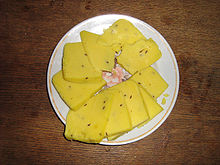This is an old revision of this page, as edited by Turaids (talk | contribs) at 21:28, 6 July 2019. The present address (URL) is a permanent link to this revision, which may differ significantly from the current revision.
Revision as of 21:28, 6 July 2019 by Turaids (talk | contribs)(diff) ← Previous revision | Latest revision (diff) | Newer revision → (diff)| Jāņi cheese | |
|---|---|
 Wheels of Jāņi cheese manufactured by "Rankas piens" Wheels of Jāņi cheese manufactured by "Rankas piens" | |
| Other names | Caraway cheese (ķimeņu siers) |
| Country of origin | Latvia |
| Source of milk | cows |
| Texture | soft, compact, slightly grainy and homogeneous throughout |
| Fat content | <30% |
| Dimensions | cylinder 4–6 cm in height and 8–30 cm in diameter |
| Aging time | at least 1–2 hours |
| Certification | TSG 2015 |
| Named after | Jāņi |
| [REDACTED] Related media on Commons | |
Jāņi cheese (Template:Lang-lv) is a Latvian sour milk cheese, traditionally eaten on Jāņi, the Latvian celebration of the summer solstice. Nowadays the cheese has also become one of the symbols of Latvian culture.
On November 16, 2015, Jāņi cheese was included in the European Council's Traditional Speciality Guaranteed (TSG) register. Currently 5 manufacturers ("Valmieras piens", "Rankas piens", "Lazdonas piensaimnieks", "Straupe", and "Dundaga") fulfil the TSG criteria and can label their product as Jāņi cheese.
Ingredients
Its basic ingredients are raw quark (Latvian: biezpiens) and fresh milk, but other products may be used as well. Traditionally, caraway seeds are added during cooking as a spice.
Making

The cheese is made by heating whole milk, adding quark, and then cooking the mixture until fluffy curds separate from a clear whey. The whey is discarded when the cheese mass reaches a temperature of 72–77 °C (162–171 °F). At this point, the curds are placed into a skillet or cooking pan, and stirred with a traditional mixture of egg, butter, salt, and caraway seeds. Once a solid, firm ball is formed, the cheese is placed in a muslin or cheesecloth to drain. Generally, the cheese is prepared a few days before eating, and is allowed to ripen in a cool place before consumption.
References
- "Jāņi cheese – a symbol of Latvian identity". Public Broadcasting of Latvia. June 21, 2019. Retrieved June 22, 2019.
- "Traditional Midsummer cheese wins EU protection". Public Broadcasting of Latvia. November 17, 2015. Retrieved June 23, 2017.
- Matisone, Gunta (May 13, 2016). "How to spot authentic Midsummer cheese". Public Broadcasting of Latvia. Retrieved June 23, 2017.
- Linda Dumpe; Anna Šmite; Aija Golde (2004). Jāņi cheese. Riga: SO „Cheese Club”. p. 204. ISBN 9984-976-20-3.
External links
- Jāņi cheese Traditional Speciality Guaranteed specification Template:En icon. Official Journal of the European Union
This cheese-related article is a stub. You can help Misplaced Pages by expanding it. |